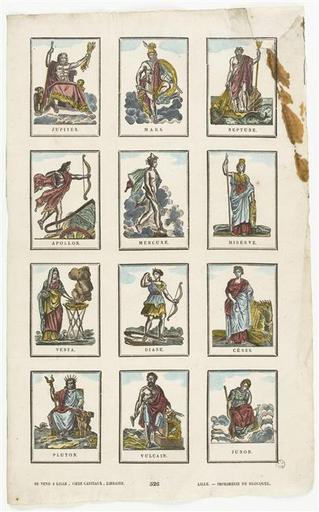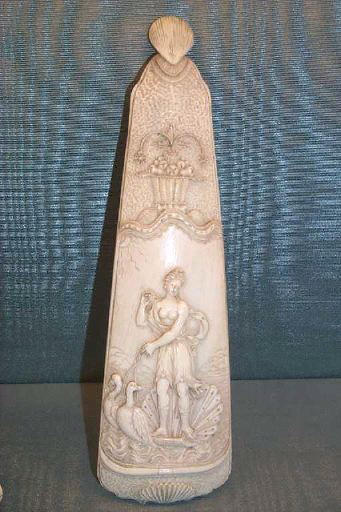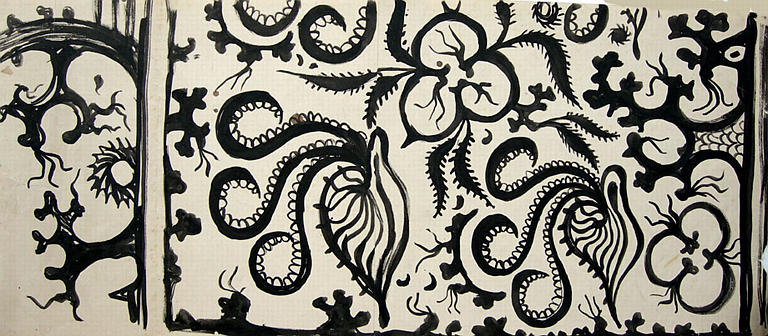Environ 230 résultats pour « Bivalvia »
-

Bivalvia
Les bivalves sont des mollusques dont la coquille est constituée de deux parties distinctes et attachées, plus ou moins symétriques, pouvant s'ouvrir ou se refermer. Cette classe comprend environ 9 200 espèces, notamment les moules, les huîtres et les palourdes. Les bivalves sont tous exclusivement aquatiques, on les trouve majoritairement en milieu marin, mais aussi dans l'eau douce (15 % des espèces environ). La classe se nomme également Bivalva, Pelecypoda (les pélécypodes) ou Lamellibranchia (les lamellibranches). Certaines espèces comme les moules s'attachent aux surfaces sous l'eau à l'aide d'un filament collant appelé byssus. D'autres s'ensevelissent dans du sable ou du sédiment. D'autres encore sont mobiles, tel les palourdes qui peuvent se déplacer dans le sable ou la vase grâce au pied musculeux.
-

Netsuké en ivoire représentant un haricot et des coquillage…
-
- Domaine(s) :
- Asie de l'Est
- Costume
- Ethnologie
- Ivoire
-
- Datation :
- XVIIIe siècle
-
-

JUPITER...JUNON (titre inscrit)
-
- Domaine(s) :
- Estampe
- Ethnologie
-
- Sujet représenté :
- Apollon
- Arc (arme)
- Barbe
- Bivalvia
- Blé
- Bouclier (arme)
- …
-
- Datation :
- XIXe siècle
-
-

LE REPOS DU CHASSEUR...LE CHIMISTE (titre inscrit)
-
- Domaine(s) :
- Chasse
- Estampe
- Ethnologie
-
- Sujet représenté :
- Berger
- Bivalvia
- Chien
- Chimie
- Cueillette
- Divertissement
- …
-
- Datation :
- XIXe siècle
-
-

-
- Artiste(s) :
- Anonyme
SANTO / ANTONIO / DE PADUA (titre inscrit)
-
- Domaine(s) :
- Estampe
- Ethnologie
-
- Sujet représenté :
- Antoine de Padoue
- Autel (religion)
- Balustrade
- Bivalvia
- Enfant Jésus
- Fleur
- …
-
- Datation :
- XVIIIe siècle
-
-

-
- Artiste(s) :
- Anonyme
60 MARSEILLE - MARCHANDS DE COQUILLAGE
-
- Domaine(s) :
- Ethnologie
- Photographie
-
- Datation :
- XXe siècle
-
-

-
- Artiste(s) :
- Anonyme
LA VIERGE FIDELE - VIERGE DE LA GROTTE
-
- Domaine(s) :
- Ethnologie
- Photographie
-
- Sujet représenté :
- Bivalvia
- Douvres-la-Délivrande
- Feuille
- Grotte
- Statue
-
- Datation :
- XXe siècle
-
-

-
- Artiste(s) :
- Anonyme
Pêcheur
-
- Domaine(s) :
- Asie de l'Est
- Ethnologie
- Ivoire
- Sculpture
-
- Sujet représenté :
- Bivalvia
- Homme
- Japonais (peuple)
- Panier
-
- Datation :
- XIXe siècle
-
-

-
- Artiste(s) :
- Anonyme
-
- Domaine(s) :
- Ethnologie
- Ivoire
-
- Désignation :
- râpe à tabac
-
- Datation :
- XIXe siècle
- XVIIIe siècle
-
-

-
- Artiste(s) :
- Anonyme
-
- Domaine(s) :
- Ethnologie
- Ivoire
- Orfèvrerie
- Production domestique
-
- Désignation :
- boîte ; couvercle
-
- Datation :
- XVIIe siècle
-
-

Les quatre parties du monde : L'Afrique, projet de décor po…
-
- Domaine(s) :
- Dessin
-
- Datation :
- XIXe siècle
-
-

-
- Artiste(s) :
- Auguste Rodin
DIVERS CROQUIS DONT DEUX LEDA AU CYGNE ET UNE FEMME TENANT …
-
- Domaine(s) :
- Dessin
-
- Sujet représenté :
- Bivalvia
- Cygne
- Femme
- Léda (mythologie)
-
- Datation :
- XIXe siècle
-
-

-
- Artiste(s) :
- Auguste Rodin
- Michel-Ange
FEUILLE DE CROQUIS AU RECTO ; FEUILLE D'ETUDES AU VERSO
-
- Domaine(s) :
- Dessin
-
- Datation :
- XIXe siècle
-
-

-
- Artiste(s) :
- Yvonne Jean-Haffen
Les moules sur le récif [titre attribué]
-
- Domaine(s) :
- Dessin
-
- Datation :
- XXe siècle
-
-

-
- Artiste(s) :
- Yvonne Jean-Haffen
Décor d'algues et de coquillages (copie d'un fragment) [tit…
-
- Domaine(s) :
- Dessin
-
- Datation :
- XXe siècle
-
-

-
- Artiste(s) :
- Yvonne Jean-Haffen
Deux poissons sur fond noir (copie de motif) [titre attribu…
-
- Domaine(s) :
- Dessin
-
- Sujet représenté :
- Bivalvia
- Crète
- Poisson
- Étoile de mer
-
- Datation :
- XXe siècle
-
-

-
- Artiste(s) :
- Yvonne Jean-Haffen
Evreux : bénitier de l'église St Taurin [titre attribué]
-
- Domaine(s) :
- Dessin
-
- Datation :
- XXe siècle
-
-

-
- Artiste(s) :
- Yvonne Jean-Haffen
La frégate La Fée (titre inscrit)
-
-

-
- Artiste(s) :
- Yvonne Jean-Haffen
Poissons coquillages et poulpes : frise décorative [titre a…
-
- Domaine(s) :
- Dessin
-
- Datation :
- XXe siècle
-
-

-
- Artiste(s) :
- Yvonne Jean-Haffen
Motifs marins (étude) [titre attribué]
-
- Domaine(s) :
- Dessin
-
- Sujet représenté :
- Bivalvia
- Corail
- Dauphin
- Poisson
- Étoile de mer
-
- Datation :
- XXe siècle
-
-

-
- Artiste(s) :
- Yvonne Jean-Haffen
Décor de faune marine (étude) [titre attribué]
-
- Domaine(s) :
- Dessin
-
- Datation :
- XXe siècle
-
-

-
- Artiste(s) :
- Yvonne Jean-Haffen
Fonds marins (étude de décor) [titre attribué]
-
- Domaine(s) :
- Dessin
-
- Datation :
- XXe siècle
-
-

-
- Artiste(s) :
- Yvonne Jean-Haffen
Maquette de la piscine de l'Aramis (Frise en 9 pièces) [tit…
-
- Domaine(s) :
- Dessin
-
- Sujet représenté :
- Bivalvia
- Poisson
- Étoile de mer
-
- Datation :
- XXe siècle
-
-

-
- Artiste(s) :
- Yvonne Jean-Haffen
Les Sirènes [titre attribué]
-
-

-
- Artiste(s) :
- Antoine Berjon
Bouquet de lis et de roses dans une corbeille posée sur une…
-
- Domaine(s) :
- Peinture
-
- Sujet représenté :
- Bivalvia
- Bouquet de fleurs
- Lys
- Nature morte
- Panier
- Rose (fleur)
-
- Datation :
- XIXe siècle
-
-

CINQ COQUILLAGES SUR UNE TRANCHE DE PIERRE
-
- Domaine(s) :
- Peinture
-
- Sujet représenté :
- Bivalvia
- Nature morte
-
- Datation :
- XVIIe siècle
-
-

SIX COQUILLAGES SUR UNE TRANCHE DE PIERRE
-
- Domaine(s) :
- Peinture
-
- Sujet représenté :
- Bivalvia
- Nature morte
-
- Datation :
- XVIIe siècle
-




